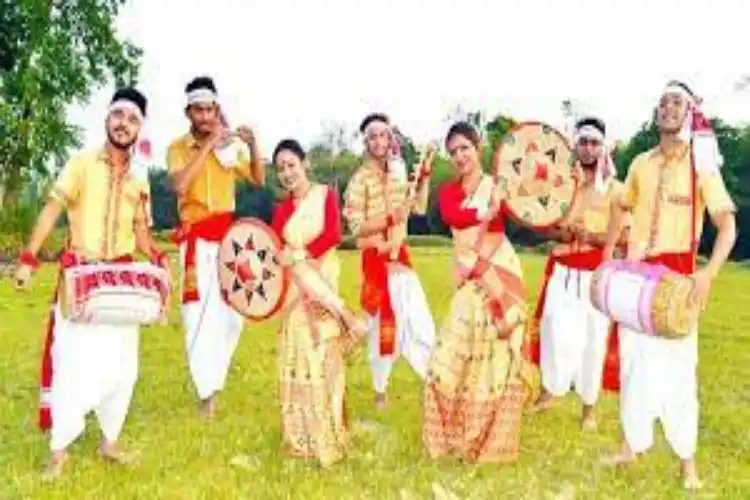
Sunil Pawan Baruah
In the middle of April, when Bishub Sankranti occurred according to the ancient Indian Calender, people of various parts of India celebrate the coming of the new year with colourful festivals, and rituals in traditional ways. If we go through the history of the Folk Culture of the world, we will observe such types of celebrations in almost every country, especially in the springtime. In the Indian context, we can mention such festivals as Ugadi in Karnataka, Baisakhi in Punjab, Gudi Padova in Maharastra, Vishu in Kerala, Navreh in Kashmir Poila Baisakh in Bengal, and Rongali Bihu in Assam.
Rongali Bihu in North Eastern India can be likened to an ideal symbol of the coordination between the Aryan Culture of Northern India and Mongoloid Culture of South East Asia. At present Rongali Bihu is recognized as the national festival of the Assamese people of the state through the indigenous communities of Assam like Bodo, Kachari, Moran, Mattak, Mising, Tiwa and Karbi celebrate it with their traditional agenda. During the 600-year rule of the Ahom Kingdom (1228 to 1826 AD), in Upper Assam, Rongali Bihu received royal patronage. Also, in a phased manner, it obtained the status of a national festival in Assam.
Thus Mukoli Bihu (Open Bihu) which evolved in Nature gradually became a mainstream festival in the capital Rangpur. It was said Rudra Singha (1696-1714), the famous Ahom king invited the leading persons of the neighbouring states for the celebration of Rongali Bihu. These celebrations went on for seven days in Ranghor, the only known amphitheater in medieval India.
Later, this festival was adopted by other Ahom rulers as a symbol of cultural unity. Even Bihu Husori (Group demonstration of Bihu dance and songs) played a vital role for the restoration of Ahom rule after it had lost the throne in a civil war during the Moamoria revolt. It must be remembered that the first historical evidence of the celebrations of Rongali Bihu is traced to the writings of Sihabuddin Talish, who came to Assam with Mirajmla, the Mughal General who occupied Gorgaon, the capital of the Ahoms for a few months in the middle of the 17th century.
However, at the end of the Ahom rule in Assam and its occupation by the East India Company through the Treaty of Yandaboo (1826), Rongali Bihu had lost its importance and status as the national festival. It was due to the influence of the conservative Bengali Culture, which found a new footing under the British Administration. As a result, a section of Assamese aristocracy and intelligentsia started denouncing Bihu as obscene and unacceptable. This was mostly from the elite section of society.
Asam Buronji (1829) written by Holiram Dhekial Phukon in Bengali gives an apt description of the outlook of the Assamese elites on the Bihu celebration in the Brahmaputra Valley. Even the Assamese students living in Calcutta in the second half of the 19th century raised the issue at the platform of Asamiya Bhasar Unnati Sadhini Sabha, a Socio – Cultural association formed in 1888. It led to a division in the association and the breakaway group organized a new forum and challenged the old association regarding the celebration of Bihu as a national festival of Assam. However, at the close of the 19th century, like in other parts of India, nationalistic ideas sprang up in Assam and naturally, the negative outlook towards Bihu had disappeared from the conservative section of society. In this background, Rongali Bihu was transformed into an active instrument for ushering the Assamese unity in the form of a National festival, particularly in the Brahmaputra Valley.
Today Bihu means mostly the Bihu songs and dances generally prevailed in upper and middle Assam. However, the system of welcoming the New Year was not unknown to different tribes and ethnic groups, and people of Assam since ancient times. However, most of such celebrations had spiritual elements and didn’t include the expression of desires of the young men and women. In this context, we can refer to rituals like Domahi, Sat Sak Tola, Powra Tola, Bhotheli, Dohar Phurua, Bihu Dia, and Souri in the undivided Kamrup and Bishhuba in Goalpara district.
Simultaneously, Bihu appeared in different forms and times among Bodo, Mising, Deuri, Lalung, Tiwa, and Hajong in both upper and lower Assam. In upper Assam, Bihu is mostly about Mukoli Bihu (Open Bihu), which later came to the family courtyards in the form of Husori, with a certain amount of spiritual touch. Nowadays, Mukoli Bihu has spread to almost every part of Assam where the festival is celebrated on the organized platforms in the month of Bohag as per the Assamese Calendar. In the post-independent era, print media like newspapers, magazines, journals, and electronic media audio and video cassettes immensely contributed to the popularization of Bihu songs and dances.
Also Read: Heritage Osmania Hospital on verge of ending as rubble
After the emergence of organized celebrations, traditional Bihu Husori has lost its relevance. However, Husori has served its historic purpose of being a symbol of solidarity and goodwill. However today, Bihu is about the glorification of the time of youth with unlimited joy and entertainment that doesn’t appreciate old customs and rituals. At the same time, we must remember the fact that Bihu is a festival that connects others with an agrarian society. So, in today’s industrialized urban society many rituals of Bihu may be irrelevant. On the other hand, the immense popularity of Bihu songs and dances paved the way for its commercialization and that led to the distortion of the traditional Assamese culture.
(Dr Sunil Pawan Baruah is a retured College Principal and lives in Guwahati)
